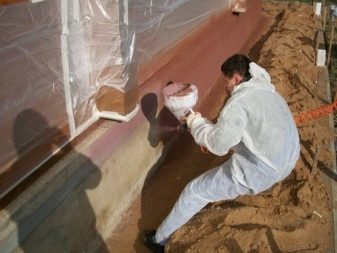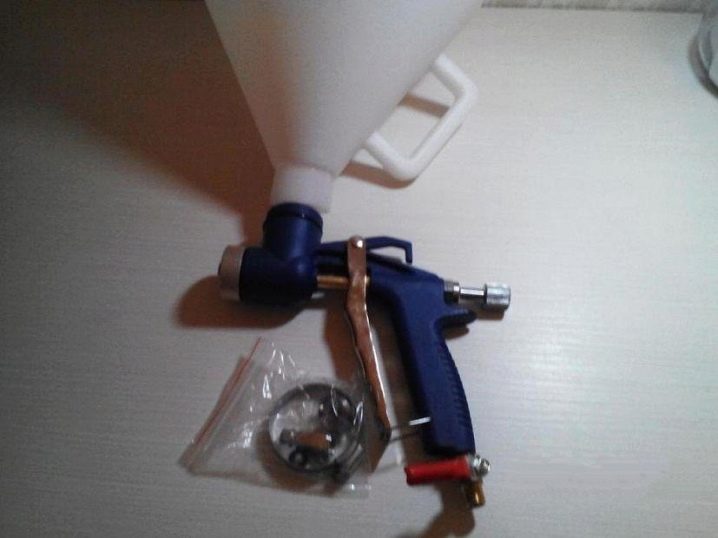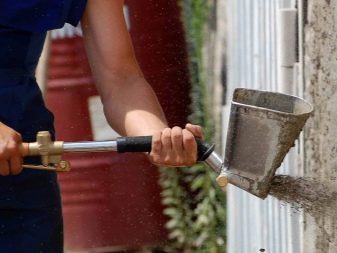Features of the use of a pistol pistol for plaster
Under the unusual name of the "pistol pistol" hides an intricate device for applying building mixtures, in particular for plastering walls. It is believed that such a device received its name from the ornament of the so-called cartouches, which this pneumogun perfectly imitates. The use of a plastering gun is most often applied if it is necessary to quickly plaster the surface.
Mechanism of action
The device resembles an atomizer with a huge funnel on top, but differs from it in the method of operation. It works with the help of a compressor that creates pressure, thereby evenly applying a plaster layer.
In order to further study the mechanism of action of the pneumogun, you must first examine in detail all the main details, since many of them, in turn, have a complex structure and are designed for various functions.
The main parts of the pistol pistol include.
- Short barrel, usually made of steel.
- Various nozzles nozzles - they will determine the future drawing.
- Funnels. Ideally, they need to have a few pieces of different volume: the best thing to choose is the volume of 3 and 5 liters.
- Special handles, with a trigger mounted on them - they are switches.
- Hollow cleaning rod - it cleans clogged holes.
- Several nozzle bodies (this is a special suction tube) that can be connected to a high pressure hose.
- Set nozzles. They depend on the thickness of the solution that must be applied. For example, such a composition as a gypsum-based solution requires a socket angle of a diffuser nozzle from 30 to 45 degrees, and for liquid mixtures it decreases to 15-20 degrees. This is done so that the applied solution does not flow down the wall. All this is very important if the repair is done by hand.
Speaking about the mechanism of action of a pistol pistol, it is important to know that it is used only for decorative plaster, and not for the main work on the alignment of the walls.
If the pneumogun is used for basic plastering of walls, then you need to be prepared for the need for high power consumption, a device with high power. Additionally, it is worth noting that the inner cone will in any case be clogged with a mixture due to its thick consistency.
An important stage of the work is the process of plaster suction in the nozzle, which includes two stages:
- suction solution in the nozzle;
- pushing the solution under pressure into the diffuser.
Professional construction teams have at their disposal the so-called "plaster station" - an automated system that is responsible for several processes at once: mixing the solution and applying pressure to the sprayer socket. This simplifies the whole process of plastering the walls.
As a rule, a home-made device of this type is a useless and dangerous unit, so buying a professional tool in the store will be both safer and cheaper.
"Hopper bucket"
Such a tool is analogous to a pistol pistol; in another it is called a pneumatic bucket, but It has the following differences from the gun:
- the resulting pressure is much lower due to the lack of compressed air in the nozzle and the loss of energy to raise the solution from the bottom of the conical funnel;
- the sprayed solution is in a separate container, which does not imply its absorption and additional energy consumption;
- The area of plaster application depends on the angle of the stream of compressed air supplied to the surface of the container with the mixture, and not on the thickness of the nozzle.
Despite all these obvious advantages of the bucket in the form of energy savings, it is better to purchase a card pistol. The latter will apply the mixture evenly and without unnecessary losses, while the consumption of the mixture when using the “Hopper bucket” will grow exponentially: first, the material consumption per unit of work time will exceed 15%, then 20% and then it will only increase.
Of course, the price of the cost of equipment for the bucket will be less, but if you need to perform a large amount of work, it is better to change your decision in favor of the gun.
It is worth noting that in most cases it is the cartridge pistol that is used for repairs.
The subtleties of working with a pistol pistol
This is one of those tools that, when used, experience is not easily desirable, but obligatory. Despite the fact that this is a kind of sprayer, in the absence of calculation or inability to "feel" the device, unforeseen problems may arise: high consumption of application materials, or even breakage of the gun.
First of all, you need to buy protective clothing. Almost complete protection will provide a protective mask of impact-resistant acrylic. Since the sprayer is almost always at eye level at work, and if the working mixture also contains fine chips or other additives, the need for its acquisition becomes doubly obvious. In addition to the eyes, you also need to protect the respiratory tract - this will help the respirator. These are the main items on the list of necessary protective clothing, which also includes gloves, overalls and shoes.
When working with an air pistol, it is necessary to adjust to the following standard parameters:
- air pressure 200-250 l / min;
- layer thickness of the applied solution 10-12 mm;
- overpressure of the compressor - 3.5-4 at.
In the course of work, the distance between the end of the nozzle and the wall is very important - it is interconnected with the thickness of the applied mixture: the thicker the solution, the smaller the distance from the wall.For liquid mixtures, the recommended working distance is 200-250 mm.
The further the gun is held, the greater the loss of consumables.
The process of applying plaster must be divided into two stages:
- first apply half of the intended thickness of the plaster;
- then, after waiting for drying, apply another half, while trying to align the irregularities.
A card pistol is used to handle large surfaces, so for a person who has not done such work before, it will be laborious, since it will require a lot of physical effort. Another additional difficulty can be to control the release lever - it also requires the application of physical force. If, nevertheless, it was decided to do the whole process independently, it is strongly recommended to map a territory of 1.5 or 2 square meters. m at a time. The consumption of raw materials for this area will be 25 kg (it is best not to fill the conical funnel as a whole, but to leave a little distance between the edges of the tank and the surface of the mixture).
When applying the material, the gun should move smoothly and evenly horizontally, while pressing the lever should be with the same pressure.The axis of the nozzle should be kept perpendicular to the wall.
The correctness of the process must be verified on site. If there are smudges, you can immediately understand that the technique of using a pistol pistol is incorrect.
Models and reviews
The following manufacturers of such a unit stand out:
- Brigadier 65019. The market price is 4,200 rubles. This production is a Swedish brand. Its main feature is a durable aluminum funnel.
- Matrix 57530. The market price is 2500 rubles.
- Fubag RK Decor - 3400 rubles.
At the moment, these models are trusted by consumers and received very good reviews. Almost all of these models have a similar structure, but differ in the country of manufacture or minor trifles. Most often, customers praise the durability of the layer of applied plaster with these pistols and the speed of the process.
Of the minuses, there is a decrease in the quality of the result when using low pressure. With this application, the solution clogs the nozzle, and then scatters into different directions in lumps and, as a result, does not fall evenly.
Buyers advise to knead the solution of medium thickness, since almost all models do not always do well with liquid or too thick mixtures.
The process of applying decorative plaster with a pistol pistol, see the following video.










































